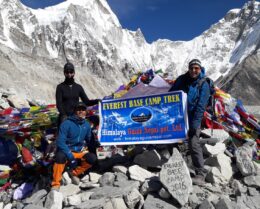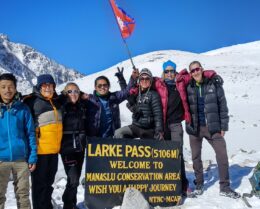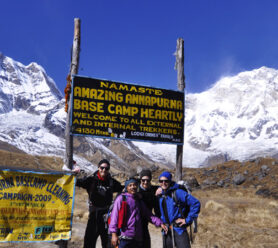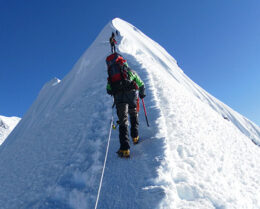Where is Larkya La Pass Situated?-The highest point in the Manaslu Circuit Trek
UPDATED ON 8 October, 2023
In the west-northwest of Nepal, between Annapurna and Langtang, is where you may go trekking over the Manaslu Larkya Pass. The eighth-highest peak in the world, Mt. Manaslu, at 8,163 meters, is the mountain that gives the route its name. Moreover, the feather of Mount Manaslu is being laid down by the 5,213-meter-high Larkya Pass. Legendary Gorkha soldiers fought on the Manaslu Larke Pass or Manaslu circuit in the Gorkha district. Catch the Annapurna conservation Area in Dharapani, which is in Nepal’s Manang district, after the Larky has passed the trails. People often wonder: Where is Larkya La Pass situated? So we will talk about it.
Nestled deep within the majestic Himalayan range, Larkya La Pass stands as a testament to nature’s grandeur and a mission to the adventurous spirit of trekkers. At an altitude of about 5,106 meters (16,752 feet) above sea level, this excessive mountain pass in Nepal gives an interesting journey via a number of the arena’s most breathtaking landscapes.
Similarly, in this 5,000-height exploration, we are able to delve into the geography, lifestyle, hiking experience, demanding situations, and the sheer beauty that makes Larkya La Pass an unforgettable vacation spot for trekkers and nature enthusiasts.

Geography and Location
Larkya La Pass is located in the northern vicinity of Nepal, inside the Gorkha District. It is a vital part of the Manaslu Conservation Area, an included area acknowledged for its pristine natural splendor and specific biodiversity.
Similarly, this far-flung skip connects the Buri Gandaki River valley to the Marsyangdi River valley and is a pivotal point at the Manaslu Circuit Trek, one of Nepal’s most renowned hiking routes.
Coordinates:
Latitude: 28.5541° N
Longitude: 84.5592° E
Manaslu Trek and Price to Travel
Since 1992, Manaslu trekking has been available. Treks up Mount Manaslu provide a unique blend of a rich cultural past, breathtaking beauty, and biological diversity. Visits to upper Manaslu trekking require special permissions.
Similarly, for the autumn season (September to November), the permit cost US$ 100 per week per person; if more than one week per day, US$ 15 per person; and for the other season (Dec. to Aug.), US$ 75 per week per person; if more than one week per day, US$ 10 per person.
Additionally, a US$30 per person per entrance Manaslu Conservation permit and an Annapurna Conservation permit are required. The Manaslu Circuit treks are thought to be among the hardest in Nepal, therefore they call for a strong background in trekking as well as excellent physical fitness.
Similarly, trekking the Larkya Pass will reward the daring with an unmatched alpine experience. Some sports called Tatopani (natural Hot Spring), Lho, Samdo Gau, Samdo, and Larky Bazaar are important to visit for real culture, real life, and unexpected variation. Likewise, if you ever wonder where Larkya La Pass is situated? Then there are all the answers
Is it feasible to climb Manaslu?
It is feasible to climb Manaslu. Guest houses or tea houses for couples, singles, or small groups. However, as a result of tourist interest and aspiration, new hotels and restaurants are constructed every year. In the majority of hotels and lodges, private rooms are provided. Shared bathrooms are the norm.
Similarly, a simple tea house or tented home is located at the Larkya Base Camp, also known as Dharmashala and Larky Phedi. “Furthermore, every guest’s home offers the typical Nepali dish Dal Bhat, which includes rice, curry, and lentil soup.
Rice, veggies, noodles, potatoes, and soup are just a few of the many culinary options available at each Guest House along our routes. The menus of several of them include Western cuisine. Most guest hotels and trailside eateries offer soft drinks, snacks, wine, bottled mineral water, and beer.
The Manaslu Circuit Trek
The Manaslu Circuit Trek is a roughly 177-kilometer (One Hundred Ten-mile) long trek that circumnavigates Mount Manaslu, the 8th maximum height in the globe. The adventure takes trekkers via a diverse variety of landscapes, from lush subtropical forests and terraced fields to alpine meadows and, finally, to the stark and snowy terrain surrounding Larkya La Pass.
Trekking Highlights:
Cultural Immersion: Along the trail, trekkers have the opportunity to engage with local groups, often the Gurung and Tibetan-stimulated individuals who inhabit the area. Similarly, the villages of Lho, Samagaun, and Samdo offer insights into the wealthy cultural history of the region.
Scenic Beauty:

The trek offers exceptional perspectives of the Manaslu massif, Himlung Himal, Cheo Himal, and different peaks within the Manaslu vicinity. These vistas change dramatically as you ascend toward Larkya La Pass, presenting a visible spectacle that is nothing short of awe-inspiring.
Wildlife Encounters:
The Manaslu Conservation Area is home to a diverse variety of flora and fauna. Similarly, trekkers might spot elusive snow leopards, blue sheep, and quite a few chook species, such as the colorful Danphe, Nepal’s country-wide bird.
Larkya La Pass: The Ascendancy
The adventure to Larkya La Pass is a sluggish ascent through ever-changing landscapes. Trekkers generally start their adventure from the village of Soti Khola, which lies at a tremendously low altitude, and step by step ascend via the valleys and villages of Machhakhola, Jagat, Deng, Namrung, Lho, and Samagaun. Each step takes trekkers closer to the heart of the Himalayas. Likewise, have you ever wondered where Larkya La Pass is situated? Then there are all the answers
Terrain and Geography:
At lower elevations, you’ll find terraced fields, lush forests, and quaint villages characterizing the trek.” The trail meanders alongside the Buri Gandaki River, with suspension bridges providing a thrilling way to cross the river’s turbulent waters.
Alpine Terrain:
As trekkers ascend further, the panorama shifts to alpine terrain. Rhododendron forests, cascading waterfalls, and herds of yaks grazing in meadows turn out to be commonplace sights. Likewise, the air grows crisper, and the nights get colder as you approach the high mountain passes.
Approaching Larkya La Pass:
The trek becomes extra tough as you close to Larkya La Pass. The terrain turns rocky and barren, and trekkers want to acclimatize cautiously to the growing altitude. Similarly, the skip itself is regularly snow-protected, and the final push to the summit can be annoying.
The Challenges of Larkya La Pass
Trekking to Larkya La Pass isn’t for the faint of heart. It gives several demanding situations that add to the attraction of this adventure.
Altitude:
The high altitude of Larkya La Pass is perhaps the maximum sizable mission. At over 5,100 meters (16,700 feet) above sea level, trekkers are exposed to thin air, reduced oxygen degrees, and the danger of altitude sickness. Similarly, proper acclimatization is essential to mitigate those dangers, and trekkers need to be vigilant about tracking their fitness.
Weather:
The weather within the Himalayas can be unpredictable. Even throughout the trekking season, which generally spans from overdue September to November and from March to May, trekkers might also encounter sudden snowstorms or unfavorable weather conditions.
Likewise, this can make the journey throughout Larkya La Pass even more hard and perilous. Furthermore, if you ever wonder where Larkya La Pass is situated? Then there are all the answers
Physical Endurance:
The trek requires a terrific stage of bodily fitness. Similarly, trekkers should be organized for lengthy days of taking walks, steep ascents and descents, and wearing a backpack with important equipment and materials. Furthermore, proper hiking equipment, such as heat apparel and strong shoes, is crucial.
Remote and Isolated:
Larkya La Pass is located in a remote and isolated area of Nepal. Access to medical facilities is confined, and trekkers should be self-sufficient with first-aid know-how and essential medicinal drugs. Additionally, conversation facilities may be scarce in certain areas of the trek.
Rewards of the Journey
The challenges of Larkya La Pass are outweighed by the rewards it offers. Here are some of the unforgettable reports and points of interest trekkers can assume:
Breathtaking Scenic Views:

From the vantage factor of Larkya La Pass, trekkers are treated to panoramic perspectives of snow-capped peaks, glacier-included slopes, and the dramatic terrain of the Himalayas. Similarly, the sight of Mount Manaslu, standing tall at 8,163 meters (26,781 ft), is a spotlight
Cultural Richness:
The villages alongside the Manaslu Circuit are steeped in culture and lifestyle. Trekkers can witness nearby rituals, explore historical monasteries, and engage with friendly villagers who provide warm hospitality. Similarly, the combo of Tibetan and Nepali cultures in this place provides its uniqueness.
Pristine Nature:
The Manaslu Conservation Area is a testimony to Nepal’s commitment to keeping its natural history. The path is teeming with biodiversity, along with precise plant life and fauna. It’s a paradise for nature fans and photographers.
Best Time to travel to Larkya La Pass Trekking
Choosing a satisfactory time to tour Larkya La Pass and explore the Manaslu Circuit is important for a secure and fun trekking revel in. Similarly, the Himalayan location, together with Larkya La Pass, reports awesome seasons, each offering specific benefits and challenges.
Moreover, here, we’ll talk about the best times to embark on your adventure: Where is Larkya La Pass situated, and which is the best time to travel there? Here is your answer.
1. Autumn (Late September to November):
Best for Most trekkers remember autumn as the suitable time to trek to Larkya La Pass.
Advantages:
Stable Weather: Autumn brings solid weather conditions with clear skies, minimum precipitation, and relatively warm temperatures all through the day, making trekking more cushty.
Stunning Views: Likewise, the clean skies provide satisfactory visibility for breathtaking panoramic perspectives of the Himalayan peaks, including Manaslu.
Cultural Festivals: Similarly, this season often coincides with numerous Nepali gala’s, permitting trekkers to immerse themselves in nearby lifestyles and witness conventional celebrations.
Wildlife Sightings: Autumn is an exquisite time for flora and fauna sightings as animals are extra energetic at lower altitudes.

Considerations:
Crowds: Since it is the peak hiking season, the paths may be rather crowded. It’s recommended for ebook resorts and allowed earlier.
Cool Nights: Although days are nice, nights at better altitudes can still be quite bloodless, so heat garb is vital.
2. Spring (March to May):
Best for Spring is every other splendid time to trek to Larkya La Pass.
Advantages:
Moderate Weather: Spring gives mild and stable weather with blooming rhododendron forests, including colorful hues to the landscape.
Fewer Crowds: Compared to autumn, there are fewer trekkers on the trail during spring, imparting a greater tranquil enjoyment.
Comfortable Temperatures: Days are pleasantly heat, and nights are not as bloodless as in iciness.
Considerations:
Unpredictable Weather: While spring is normally favorable, there can be occasional rain showers at lower elevations, so waterproof tools are vital.
Lingering Snow: At better altitudes, some sections of the trail may additionally still be protected with snow, requiring cautious navigation.
3. Winter (December to February):
Best for Experienced trekkers who are cushy with severe bloodless and difficult situations and may also not forget hiking in iciness.
Advantages:
Solitude: Winter sees only a few trekkers, providing an experience of solitude and quietness on the trail.
Clear Skies: Despite the cold, you could revel in clean skies and unobstructed views, in particular in December.
Unique Scenery: The snow-included landscape adds a unique allure to the trek, creating a pristine and serene environment.
Considerations:
Extreme Cold: Winter temperatures at excessive altitudes can plummet nicely below freezing, making it a difficult and potentially risky time to trek.
Limited Facilities: Many teahouses and motels along the route can be closed due to the low number of trekkers. You’ll need to hold OK components and be self-sufficient.
Shorter Days: Daylight hours are shorter in iciness, so trekkers need to plan their day-by-day distances consequently.
4. Summer (June to August):
Best for Summer isn’t the recommended time to trek to Larkya La Pass because of the monsoon rains.
Considerations:
Monsoon Rains: The monsoon season brings heavy rainfall, landslides, and swollen rivers, making the paths muddy, slippery, and probably risky.
Lack of Visibility: Frequent cloud cowl can obscure the stunning mountain perspectives.
Leach and Insect Activity: The heat and moist situations are conducive to leach and insect hobby, which may be bothersome.
In the end, the high-quality time to tour Larkya La Pass and adopt the Manaslu Circuit Trek is for the duration of the fall months of late September to November or within the spring from March to May.
Similarly, these seasons offer a satisfactory mixture of favorable weather, clear skies, and relatively fewer crowds, offering a top-quality trekking revel. However, your choice ultimately depends on your preferences and your capacity to evolve to the precise situations of every season.
A cellular smartphone reception and net admission to all through the trek
Mobile cell phone reception and net admission may be restricted in positive regions of the trek. While some villages have communication centers, trekkers should be organized for stretches with no connectivity.
Alternative trekking routes or side journeys in the Manaslu Region
Besides the primary Manaslu Circuit trek, there are alternative routes and side journeys, which include the Tsum Valley trek, which lets trekkers discover greater faraway and culturally rich areas within the Manaslu vicinity.
Trekking Group size allowed for the Manaslu Circuit trek
As of my ultimate information replacement in September 2021, the maximum size allowed for the Manaslu Circuit trek is typically constrained to fifteen trekkers in line with the group. This law may also trade, so it is essential to test with nearby authorities or hiking groups for the most up-to-date data.
Conclusion
Larkya La Pass stands as an image of the indomitable human spirit and the allure of the Himalayas. It demands trekkers each physically and mentally however rewards them with unequaled natural beauty, cultural stories, and a feel of festivity. So, I hope you got answers on Where is Larkya La Pass situated.
This far-off corner of Nepal invites adventurers to embark on an adventure of an entire life, where each step takes them toward the heart of the Himalayas and their very own internal barren region. Similarly, as trekkers descend from Larkya La Pass, they create with them not only recollections of an epic journey but also a profound connection to the majesty of the mountains and the long-lasting spirit of Nepal’s human beings.
FAQ for the trek
Where is Larkya La Pass situated?
Larkya La Pass is located in the northern vicinity of Nepal, within the Gorkha District. It is part of the Manaslu Conservation Area, nestled within the coronary heart of the Himalayas.
What is the altitude of Larkya La Pass?
Larkya La Pass stands at an elevation of approximately 5,106 meters (16,752 feet) above sea level, making it one of the high mountain passes within the Himalayas.
What is the Manaslu Circuit trek?
The Manaslu Circuit trek is a popular hiking direction that circumnavigates Mount Manaslu, the 8th maximum peak within the globe. It takes trekkers through numerous landscapes, including lush forests, charming villages, and in the long run, the tough Larkya La Pass.
When is the great time to trek to Larkya La Pass?

The fine instances for trekking to Larkya La Pass are inside the autumn months (overdue September to November) and the spring months (March to May). Similarly, these seasons provide solid weather, clear skies, and exceptional temperatures, making for an excellent hiking experience.
What are the challenges of trekking to Larkya La Pass?
Trekking to Larkya La Pass affords challenges inclusive of high altitude, unpredictable climate, steep ascents and descents, and the need for correct acclimatization. Trekkers should additionally be prepared for cold temperatures and the possibility of altitude illness.
How long does the Manaslu Circuit trek take?
The period of the Manaslu Circuit trek can vary depending on your starting point and tempo. In common, it takes approximately 14 to 17 days to complete the trek, which includes time for acclimatization and side trips.
Do I want a special permit to trek inside the Manaslu Conservation Area?
Yes, trekkers are required to attain special lets into the Manaslu Conservation Area. Similarly, these allowances are generally arranged via a registered hiking corporation, and it’s critical to have the important documents earlier than embarking on the trek.
Are there hotels and teahouses alongside the Manaslu Circuit trek?
Yes, there are teahouses and inns along the trekking course, offering fundamental lodging and food. Similarly, it’s recommended to e-book accommodations in advance in the course of the height trekking seasons.
Is it essential to rent a guide and porter for the Manaslu Circuit trek?
While it is not obligatory to rent a guide and porter, many trekkers opt for their offerings for added convenience and support. Guides can provide valuable neighborhood insights, and porters can convey heavy backpacks, permitting trekkers to enjoy the adventure more effectively.
Are there opportunities for cultural studies along the trek?
Yes, the Manaslu Circuit trek gives ample possibilities for cultural immersion. You can go to traditional villages, and monasteries, and have interaction with nearby communities, including the Gurung and Tibetan-prompted folks who call this region home.
You may also like




